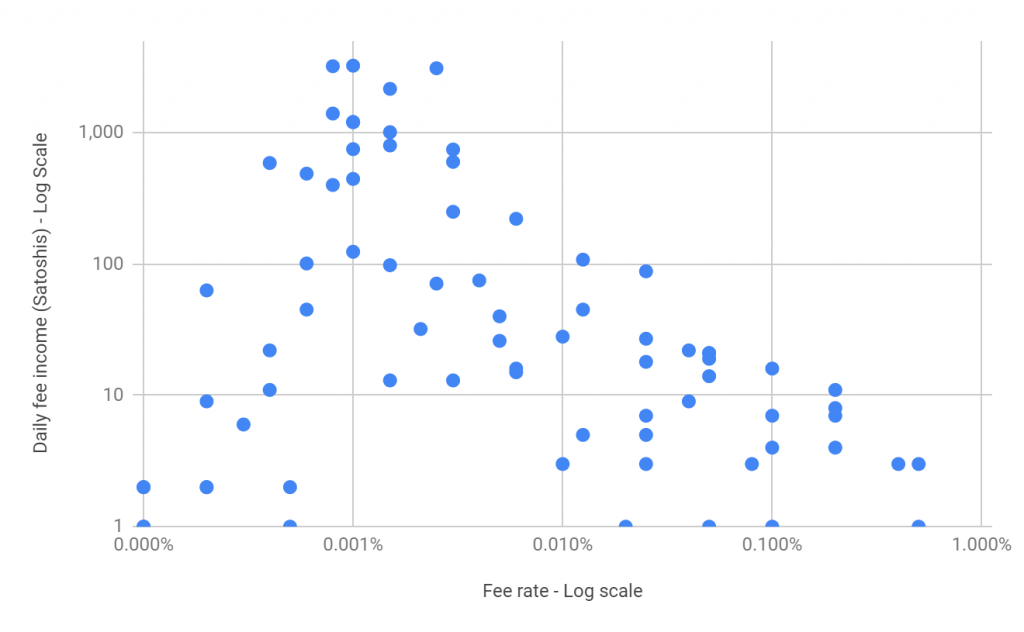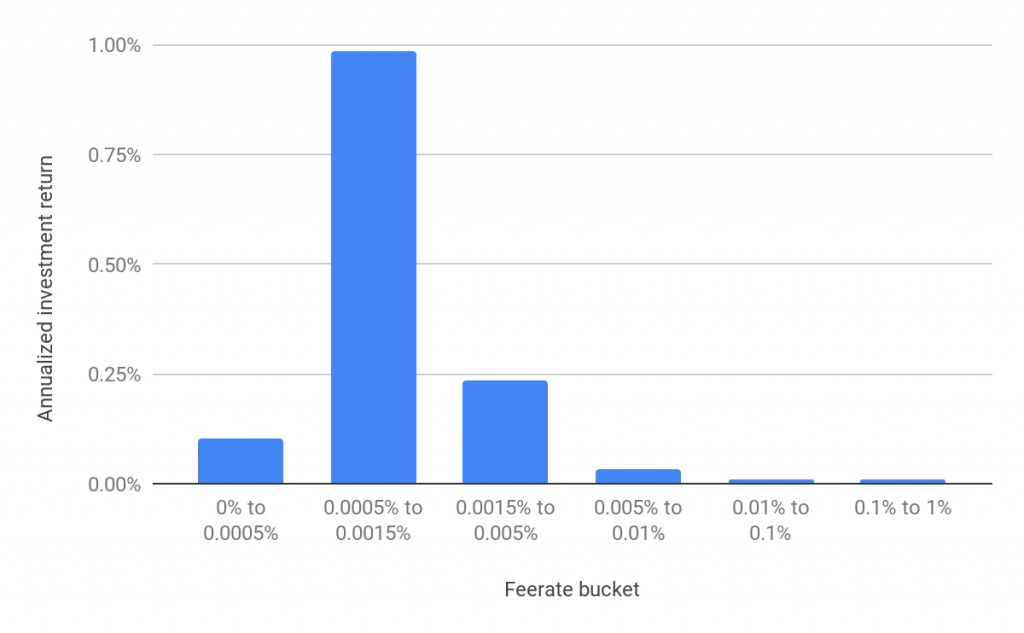Lightning Network Routing Cost Economics
Abstract: The BitMEX research team studied the market dynamics of lightning network routing fees and the financial incentives to provide liquidity for lightning node operators. We have discovered the interrelationship and balance between the lightning routing fees and return on investment of channel liquidity providers, which is a major challenge for the network, not the computer science aspect of routing problems. We conclude that if the Lightning Network expands (at least in theory), the environment of a broader financial market (such as interest rate changes and investor sentiment) has an opportunity to influence the market for lightning network fees. However, regardless of the current economic environment, we believe that in the long run, competition will be the main driver of price. A low barrier to entry into the market may mean that the balance point will benefit the user and the low commission, not the return on investment of the liquidity provider.

(Lightning hits Singapore City) ( Pexels )
Overview
- USDT fights hormones, long and short double burst 5/26 market analysis
- Introduction | Lightning VS Lightning: Watchtower Mode (below): Business Model
- There is no reason to believe in the blockchain?
The first time we wrote about the Lightning Network was in January 2018 , when it was mainly theoretical. Now, as the lightning network moves from abstraction to experimentation, we think it's time to look at it again. The main focus of this report is to analyze the lightning network from the perspective of finance and investment, especially the charges and incentives of lightning network providers. We will not study other aspects of technology.
Routing problem
Critics of Lightning Networks often point out that routing is a major issue and is often referred to as "an unresolved computer science problem." In general, we do not fully agree with this characterization of routing problems, and do not consider the computer science of routing to be a major challenge. It may be relatively straightforward to find a path from a different channel, and with other P2P The network is similar, such as bitcoin.
However, we do believe that the interaction or balance between liquidity provision and the financial and economic aspects of payment routing is one of its main challenges. Lightning network operators need to be motivated by routing fees to provide sufficient liquidity for the payment to proceed smoothly. Mobility needs to be clearly assigned to the channels that are in demand, and identifying them can be challenging, especially when new businesses enter the network. This balance between ensuring that the network has low commissions for users and ensuring that fees are high enough to generate incentives for liquidity providers may be a major issue. As we will further explain in this article, the importance of this issue and the rate at which the market liquidates may depend on the economic environment.
Lightning network fee market dynamics
For bitcoin transactions on the chain, the user (or their wallet) determines the commission for each transaction at the time of payment, and then the miner attempts to maximize the formalities by selecting a transaction with a higher handling fee per unit block weight. Fee income. In contrast, Lightning Networks currently appears to be operating in another way, with routing node operators setting fees, and then users selecting paths for their payments and selecting channels to minimize commissions. For Lightning Networks, the vendor initially sets the commission, not the user. Therefore, Lightning Network can provide a superior charging structure, because suppliers provide specialized services, and it is more appropriate for suppliers to compete with each other (rather than ordinary users). The priority is simplicity. .
In the lightning network, there are two types of routing fee node operators that must be noted, namely the base fee and rate.
Two lightning network fees

Investment funds
In order to provide liquidity for routing payments and earn fee income, Lightning Node operators need to lock funds (bitcoin) within the payment channel.
Two channel capacities

Graphical illustration of channel inbound and outbound capacity 
(Source: Bitcoin Lightning Wallet )
(Note: orange balance is inbound capacity, blue balance is outbound capacity)
Lightning fee market operation
To be a successful routing node is harder than you think. As of this writing, there are currently 7,615 public lightning nodes based on 1ml.com data. However, in terms of managing nodes, rebalancing channels, and setting fees in an appropriate manner, only a few hundred of them do a good job of providing liquidity.
The node runner may need to:
● Adjust rates and base fees, monitor the impact of adjustments, and calibrate for optimal revenue maximization settings
● Analyze the network and look for lightning nodes with high payment requirements and poor connectivity, such as new merchants
● Analyze the fee market, not only for the overall network, but also for high-demand, low-capacity paths that are being targeted
● Continuously monitor and rebalance your channels to ensure adequate two-way mobility
● Implement a customized backup solution for the latest channel state to protect funds when a node computer crashes
Currently, there is no automated system capable of implementing the above functions. If this does not change, it may be necessary to set up a dedicated business to provide liquidity for the lightning network. However, as with liquidity, the challenge of overcoming these technical issues does not necessarily mean that payments will become very difficult or expensive. These technical challenges may only adjust the equilibrium market rate. The more difficult it is to overcome these problems, the higher the potential return on investment that channel operators will receive, and the greater the incentive to solve them. What drives the success of Lightning Networks will be demand, not the challenges faced by node operators.
In order for the lightning commission market to operate effectively, the node operator may need to adjust the commission based on the competitive landscape, which may be based on an algorithm or a manual process with the goal of maximizing fee income. In order to simulate the standard practices that may eventually be formed, the BitMEX research team tested this and revised the rates for one of our nodes over a three-month period, as described below.
Rate test
The BitMEX research team decided to conduct a basic test to test and evaluate the status of the fee market, although the Lightning Network is still in a new state. We built a lightning node and periodically modified the rates to try to determine which rates would maximize the fee income, just as the lightning network scaled-scale node operators ultimately expected to do.
We use the following scatter plot to illustrate the basic non-scientific analysis we performed through a node. It seems to indicate that the current rate does have an impact on the fee income of the Lightning Node. When the rate increased from 0 to about 0.1/10,000, the daily fee income showed a rapid acceleration. Once the fee is raised above this rate, the average daily fee income shows a gradual decline. Therefore, according to this trial, it seems that the rate of income maximization is about 0.1%, which is undoubtedly very low compared to other payment systems. However, of course, this is only a fee for a hop, and a payment may have multiple hops. At the same time, the lightning fee market is almost non-existent. In fact, the BitMEX research team may have been one of the few lightning nodes that have meaningfully tested the behavior of maximizing economic income by changing fees. Once the network is scaled up and other participants try to maximize revenue, the market for the fee market can be very different. Therefore, this operation can only be regarded as an illustrative test, not a specific disclosure of the lightning fee market.
Lightning node daily fee income and rate comparison

(Source: BitMEX Research Team )
(Lightning fee income data map – notes and instructions:
* Daily data from December 31, 2018 to March 24, 2019
* Data comes from a lightning node
* The base fee for the entire period is 0
*The return on investment data does not include the bitcoin transaction fee on the chain. When the fee is affected, all groups except the optimal rate will show a negative return on investment.
* Data includes weekdays and weekends. In general, lightning network traffic is much lower on weekends.
*The rate is changed every day around 21:00 UTC. Decrease the rate every day, jump to the top of the rate range after a few days of downgrade, and then start the next rate reduction cycle. This is done because some wallets (such as mobile wallets) do not query the rate every time they try to provide a path for a payment through a node, so many payments will fail when the rate is raised. For example, when opening a channel from a mobile wallet to a lightning node, then raising the rate and immediately attempting to pay, the payment typically fails because the wallet attempts to pay at a previously low commission. We believe that in order for the lightning network fee market to operate effectively, the node operator may need to change the fee on a regular basis, so the wallet may need to check the rate more frequently.
* Manually re-balancing the channel every two weeks. It takes about 30 minutes each time
* Lightning node runs LND, software connects host to update every two weeks
* About 30% of the channels (by value) are open with Autopilot and the remaining 70% are manually opened
* Return on investment is calculated by using the daily outbound channel capacity of the network, annualizing the return on investment based on daily fee income, and then calculating a simple average based on all days of a certain rate in a specific interval.
* Data is based on only one node and the specific channel set of the node. The experience of other node operators may be very different.
* We tried to use our public node for this test, but the fee income was too scattered, and some network participants regularly paid a fee that was significantly higher than the published rate, making the data unreliable.
* Unfortunately, both of our axes require a logarithmic scale. In terms of rates, we are not sure what rate to charge, or even which order of magnitude, so we have tried a wide range of commission rates, from 0.0001% to 0.5%, and the logarithmic scale is appropriate. At the same time, daily fee income fluctuated widely, ranging from 0 Satoshis to more than 3,000 Satoshis. So the logarithmic scale seems to be the most appropriate. Linear scales may become more appropriate as the network evolves and becomes more reliable, as well as the more circulated marketplace transactions. )
Fee income and return on investment
In addition to daily fee income, you can also consider the annualized return on investment associated with running a lightning node and various rates. This return on investment is calculated by annualizing the daily fee income and then dividing by daily outbound liquidity.
The highest annualized return on investment achieved in the trial was 2.75%, while the return on investment in the highest commission group was approximately 1%. For an investment theory that should theoretically be relatively low risk, this seems to be a reasonably attractive return, at least the ability to back up the lightning channel in real time is implemented. Existing Bitcoin investors may be attracted by these returns and provide liquidity to the Lightning Network, or USD-based investors may also buy Bitcoin, use leverage to hedge Bitcoin price risk, and then try to earn lightning network procedures Fee income.
Lightning node annualized investment return for different fee groups

(Source: BitMEX Research Team )
Of course, these return on investment may not be able to motivate liquidity providers in the current lightning network. Current node operators may be amateurs, and most of the node operators are losing money when considering the chain charges required to open and rebalance the lightning path. While this amateur-based mobility can sustain the network for a while, in order to meet the large-scale requirements of many people for lightning networks, a potential return on investment is needed to attract investors.
Lightning network fee and economic environment
In the current low-yield environment, a 1% return on investment may seem attractive, but Lightning Networks may initially be difficult to attract suitable commercial liquidity providers. Investors in this sector generally seek high-risk, high-return investments, and this relatively low-risk, low-return for lightning liquidity providers seems to be at another extreme. It may therefore be necessary to have a new investor category, the investor category that matches this situation.
If the lightning network reaches a large scale, it may be that this investment product with stable low-risk returns and high liquidity will be sensitive to the economic environment.
Consider the following scenario:
1. The Fed's base rate is 1.0%.
2. Lightning node operators typically earn a 1.5% annualized return on investment for their outbound balance.
3. Due to the strong economic environment and inflationary pressures, the Federal Reserve Open Market Committee raised the interest rate from 1% to 3%.
4. As the return on investment is more attractive, Lightning Network node operators withdraw funds from the Lightning Network and buy government bonds.
5. Due to the reduced mobility in the lightning network, users pay a higher fee for making payments, and lightning networks become more expensive.
However, if the lightning network mobility is large enough to fit the above logic, the lightning network is already an amazing success.
Risk-free rate of return
To a certain extent, if the lightning network matures, investors can even consider the return on investment running the lightning node as the risk-free rate of return of bitcoin, or at least the rate of return without credit risk. In traditional finance, this is usually the rate of return earned by investors holding government bonds, where the government has a statutory obligation to pay the principal and coupons and a means of creating new funds to pay the bondholders, so the risk is close to zero. In theory, all other investment projects or loans in the economy have a higher return than this risk-free rate of return. The same theory applies to Bitcoin, which treats the return rate of a lightning node liquidity provider as the underlying interest rate within the Bitcoin ecosystem.
In the future, if most of the challenges involved in running a node have been overcome and there is a competitive fee setting algorithm, the risk-free rate of return for this lightning network may ultimately be determined by:
● Macro financial market environment – the higher the interest rate, the higher the risk-free rate of lightning network
● Demand for lightning network transactions – increased demand or faster capital flow, should increase the risk-free rate of lightning network
in conclusion
Will professional hedge funds and venture capital investors behave the same as the “staking as a service” business model of the Prosperity Proof (PoS) system in 2018? The enthusiasm remains to be seen. While the return on investment of the Lightning Network Liquidity Provider seems to be unattractive, we are indeed seeing the potential benefits of this business model as the network is in its formative stage.
We believe that Lightning Network can easily reach the scale of Bitcoin's current chain transactions without encountering any economical fee market cycles or problems, all based solely on amateur liquidity providers. However, if the network is to reach the scale desired by many lightning network advocates, it needs to attract the liquidity of investors who are eager to benefit from the pursuit of risk-adjusted return on investment income. If so, unfortunately, as the investment environment changes over time, the network's fee market conditions may change significantly.
However, it is relatively easy to build nodes, provide liquidity, and earn fee income by reducing the income of peers. We will not know where the operational channel of the operating node, the degree of liquidity provision, and the return on investment will eventually reach a balance. However, if we must make a guess, according to the architecture and design of the lightning network, we believe that the system will be more inclined to users and low fees, rather than liquidity providers.
Author: BitMEX team
Weibo: BitMEX
WeChat public number: BMEX industry information
Knowing the number: BitMEX research
Official telegram group: https://t.me/BitMEX_China
Welcome to reprint, please indicate that the article is provided by BitMEX research team. For more research reports on cryptocurrency industry, please visit http://cn.research.bitmex.com
We will continue to update Blocking; if you have any questions or suggestions, please contact us!
Was this article helpful?
93 out of 132 found this helpful
Related articles
- Noise trader
- Where is the Schnorr signature and the Taproot soft fork proposal?
- Breaking the blockchain impossible triangle (3) – POS and POW-DAG
- Video|"8Q" HashQuark Li Chen: PoW spelling power, hard core! PoS fights soft power and diversity!
- Market Analysis: BTC continues to be at $8,000, the main force is more patient than expected
- Market Analysis: BTC continues to shrink, has to change?
- DeFi: Is it a new bottle of old wine, or is it a real future finance?






